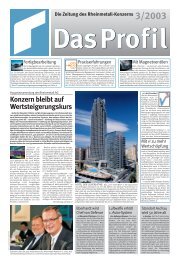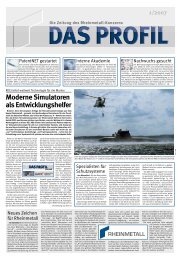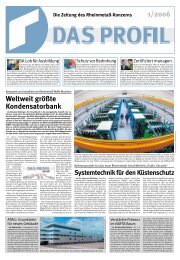PDF [1.6 MB] - Kolbenschmidt Pierburg AG
PDF [1.6 MB] - Kolbenschmidt Pierburg AG
PDF [1.6 MB] - Kolbenschmidt Pierburg AG
You also want an ePaper? Increase the reach of your titles
YUMPU automatically turns print PDFs into web optimized ePapers that Google loves.
Newsline<br />
<strong>Pierburg</strong> GmbH’s Emission Control business unit powerfully positioned worldwide<br />
A talented specialist<br />
in emission reduction<br />
Neuss. For almost 18 months now, <strong>Pierburg</strong>’s former Emission Control product<br />
group has been operating as an autonomous profit-center style business<br />
unit. With altogether four locations outside of Germany in Lanciano, Italy, Ústí<br />
nad Labem, Czech Republic, Abadiano, Spain, and Fountain Inn, USA, as well<br />
as three German plants in Neuss, Berlin and Hartha, this unit is a globally<br />
successful specialist in all aspects of automotive emission reduction, specifically<br />
nitrogen oxides (NOx) and hydrocarbons (HC). <strong>Pierburg</strong>’s emission-reduction<br />
systems, particularly the various exhaust gas recirculation (EGR)<br />
valve options, are nowadays employed by nigh all the international carmakers.<br />
sman Sari, Senior Manager<br />
Development for<br />
EGR (automobiles), explains<br />
the available<br />
product range: “Our<br />
lineup comprises solutions<br />
for both sparkand<br />
compression-ignition engines, for<br />
automobiles and trucks. In all these instances,<br />
the EGR valve in all its manifold<br />
options is our star product. Irrespective<br />
of whether pneumatic, electric<br />
or motor actuated, with or without<br />
bypass, with or without the new cooler<br />
unit, over six million valves are sold annually<br />
to the international automotive<br />
OEMs, representing indisputable proof<br />
of their star quality. We are in a position<br />
to offer our customers precisely<br />
what they need, from rugged, generalpurpose<br />
solutions to components em-<br />
bodying maximum controllability and<br />
dynamic response. Those customers<br />
combining our EGR valves with other<br />
<strong>Pierburg</strong> options such as the aluminum<br />
cooler or the exhaust-gas flaps for regulating<br />
pressure differences, achieve<br />
further marked reductions in nitrogen<br />
oxide emissions.“<br />
Javier Egurrola, Head of the Emission<br />
Control unit, adds: “Besides the recirculation<br />
of exhaust gas, the use of secondary<br />
air systems is another proven<br />
option for lowering gasoline engine<br />
emissions. Injecting air into the exhaust<br />
gas manifold results in an<br />
exothermal oxidation of the hydrocarbons<br />
still remaining in the exhaust gas<br />
which, in turn, leads to a significant reduction<br />
in these emissions and also in<br />
carbon monoxides. A spin-off: the heat<br />
released by this reaction assists the<br />
downstream catalytic converter in<br />
reaching more readily its operating<br />
temperature, essential in achieving further<br />
emission reductions. Here, too, we<br />
have the suitable systems.“<br />
Dr. Holger Paffrath, Senior Manager Development<br />
for Secondary Air Systems,<br />
explains: “Besides our standard classic<br />
comprising a low-noise secondary air<br />
pump shielded against spray and dust<br />
by a welded plastic housing and driven<br />
by an encapsulated D.C. motor, we have<br />
since 2003 also been offering a larger,<br />
low-noise secondary air pump able to<br />
feed sufficient secondary air to both high<br />
capacity gasoline engines and vehicles<br />
12<br />
with engine compartments having limited<br />
installation space. Either pump can<br />
be mounted to the engine or the body of<br />
the car. For the latter option we also supply<br />
a modular assembly kit comprising a<br />
clamp and absorbers to eliminate structure-borne<br />
noise.“<br />
Paffrath goes on: “To avoid an exhaust<br />
gas backflow into the secondary air<br />
pump or its immediate environment as<br />
well as any uncontrolled influx of air into<br />
the exhaust system outside of secondary-air<br />
operation, we are also offering<br />
three different types of secondary air<br />
valve: firstly, an on/off check valve (remarkable<br />
for its low pressure-losses);<br />
secondly, our vacuum-independent secondary<br />
air valve that opens automatically,<br />
depending on the pressure generated<br />
by the secondary air pump and can<br />
therefore dispense with an electric actuator<br />
and all the vacuum hose lines and,<br />
thirdly, our electric secondary air valve<br />
that combines the advantages of the<br />
check valve with those of the secondary<br />
air valve while offering the added benefits<br />
of rapid opening/closing times and<br />
ample opening force. This electric secondary<br />
air valve can also been fitted with<br />
an integrated pressure sensor to address<br />
future requirements regarding onboard<br />
diagnosis (OBD II) and electronic<br />
on-board diagnosis (EOBD).“<br />
The third product group comprises<br />
the already-mentioned exhaust-gas<br />
flaps. These flaps are not only used to<br />
reduce emissions, they also enhance<br />
vehicle drivability. Dr. Karl-Heinrich<br />
Talented specialists in emission reduction: Javier Egurrola (r.) and Osman Sari seen here with a motor-actuated EGR valve.<br />
Lösing, Senior Manager Development<br />
for EGR valves (trucks) and for exhaustgas<br />
flaps, comments: “In the case of<br />
emission control, these flaps can be<br />
combined with DeNOx catalytic converters,<br />
in other words converters for<br />
abating nitrogen oxide emissions. By<br />
(Continued on page 13)<br />
Photo: Markus J. Ferger


![PDF [1.6 MB] - Kolbenschmidt Pierburg AG](https://img.yumpu.com/8657804/12/500x640/pdf-16-mb-kolbenschmidt-pierburg-ag.jpg)
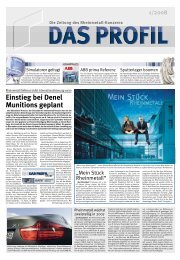



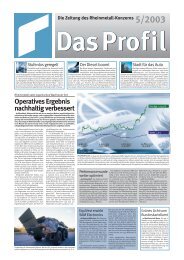
![PDF [2.4 MB] - Kolbenschmidt Pierburg AG](https://img.yumpu.com/8295864/1/184x260/pdf-24-mb-kolbenschmidt-pierburg-ag.jpg?quality=85)
![PDF [2.5 MB] - Kolbenschmidt Pierburg AG](https://img.yumpu.com/8112793/1/184x260/pdf-25-mb-kolbenschmidt-pierburg-ag.jpg?quality=85)




